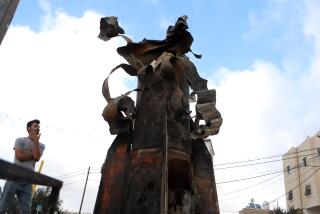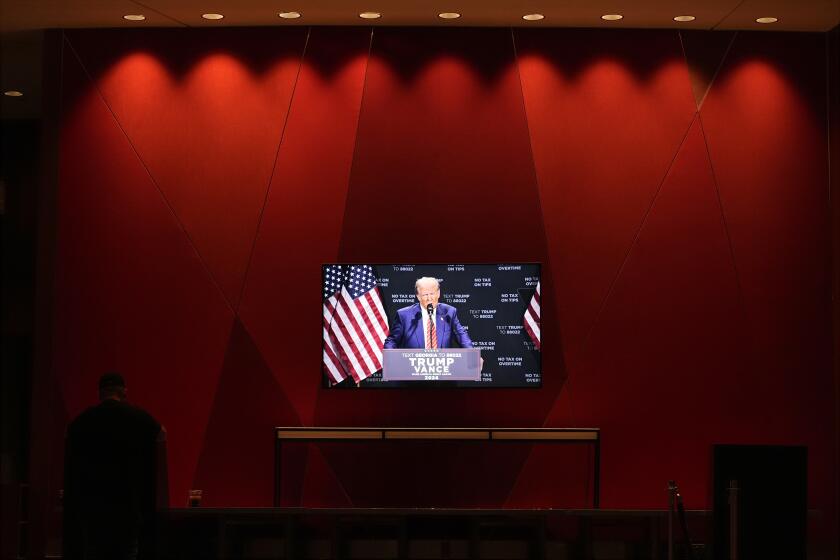Column: The new nuclear arms race
Former Defense Secretary William J. Perry, one of the nation’s wise men on national security, delivered an arresting message last week: We’re about to find ourselves in a new nuclear arms race.
“The danger of a nuclear catastrophe today is greater than during the Cold War,” Perry said.
The danger stems not only from terrorist groups like Islamic State, which would gladly steal or buy nuclear material on the black market, but also from the huge nuclear arsenals the United States, Russia and other big powers maintain more than 20 years after the end of the Cold War. Those nuclear forces are bigger than they need to be — almost 16,000 warheads in all. And they still include hundreds of missiles on hair-trigger alert.
If an apparent attack against U.S. missile bases is detected, officials will have only a few minutes to decide whether to launch the missiles in response, or lose them.
“We’ve avoided a catastrophe more by good luck than by good management,” Perry told a meeting at the Atlantic Council, a nonpartisan think tank.
In 2007, Perry joined with former Sen. Sam Nunn and former Secretaries of State Henry A. Kissinger and George P. Shultz — two Democrats, two Republicans — to urge that the U.S. make the abolition of nuclear weapons a formal goal. President Obama embraced the idea, negotiating a treaty with Russia to cut both countries’ arsenals.
But since that 2010 pact, progress toward nuclear disarmament has virtually stopped. Both Russia and the U.S. have launched expensive plans to modernize their nuclear forces, reaffirming the weapons’ central role in national security. In Obama’s case, the modernization program, which will cost an estimated $355 billion over 10 years, was the price of winning Republican votes in the Senate to ratify the 2010 treaty.
As Russia builds new weapons, Perry said, “I have no doubt that the United States will follow suit.”
So Perry is trying to revive a proposal that a handful of arms control advocates have floated in previous years: The U.S. should eliminate all of its 400-plus land-based nuclear missiles.
For decades, U.S. nuclear strategy has relied on a “triad” of weapons platforms: land-based missiles or ICBMs, manned bombers and submarines.
The basic idea was redundancy: If one system was knocked out by an enemy, the others would still be available.
Over the years, however, U.S. nuclear submarines have become virtually undetectable. Stealth bombers are difficult for opponents to find, as well.
The land-based missiles, by contrast, are more vulnerable. They’re stuck in one place. Their locations are known to the Russians and other potential enemies.
That means they face a dilemma known as “use it or lose it.” If an apparent attack against U.S. missile bases is detected, officials will have only a few minutes to decide whether to launch the missiles in response, or lose them.
And that makes them susceptible to false alarms — which actually occurred several times in both the U.S. and Russia during the Cold War. (Luckily, officers realized that their radar was malfunctioning.)
That vulnerability is still there. “The way to solve it is simply to eliminate the ICBMs,” Perry said.
It’s an unorthodox suggestion, and there are counter-arguments, of course — mainly that ICBMs provide insurance if an adversary somehow knocked out every submarine and every bomber.
But the doctrine sometimes sounds more like force of habit.
“It has worked for us for decades,” Air Force Secretary Deborah James told a congressional committee last month. “The ICBMs are considered responsive, the sea-launched are considered survivable, and the bombers ... are flexible.”
I think Perry has the better argument. The case for keeping land-based missiles is weak. The danger they present is real.
But what I’d mostly like to see is a serious debate on these issues among the candidates for president.
Sen. Bernie Sanders has said he thinks the modernization plan is a waste of money. Hillary Clinton has suggested that she’s worried about the cost, but hasn’t taken a firm position. Sen. Ted Cruz has said he wants to spend more money on defense, including nuclear weapons.
And Donald Trump? When conservative radio host Hugh Hewitt asked Trump for his position on the nuclear triad last year, the businessman was flummoxed.
“For me, nuclear is just the power,” Trump replied. “The devastation is very important to me.”
We deserve better answers. It’s a matter of survival.
Twitter: @doylemcmanus
Follow the Opinion section on Twitter @latimesopinion and Facebook
More to Read
A cure for the common opinion
Get thought-provoking perspectives with our weekly newsletter.
You may occasionally receive promotional content from the Los Angeles Times.











